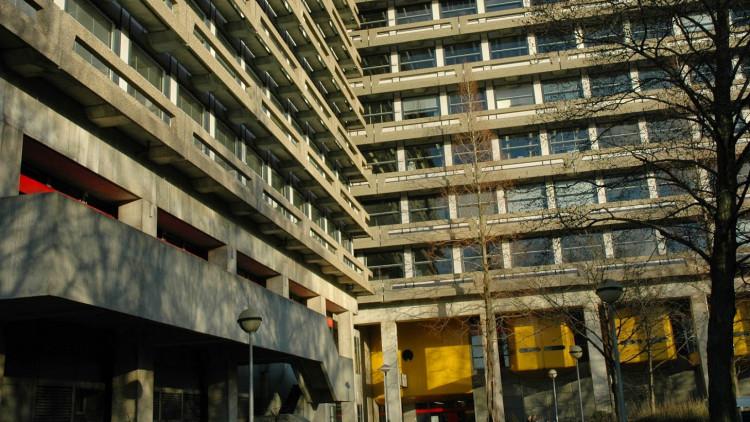New opportunity for Kruyt building

The university is investigating whether the Kruyt building can be renovated while being inhabited. At the end of May, test measurements will be carried out into noise and vibrations from demolition and drilling activities in the vacant west wing. The idea is that the four wings of the Uithof colossus can be stripped down to the concrete frame and then rebuilt. In addition, the procurement costs must be calculated.
Or two new buildings?
The move is unexpected. Until now, most science students have assumed that the outdated Kruyt building will be demolished or given a different purpose. In recent years, the discussion has focused almost exclusively on two new buildings that would replace the Kruyt building, the Ornsteing building, and the Carolien Bleeker building.
It concerns a new home for the lifescience scientists on the north side of the David de Wied building and a new building for the Debye Institute for Nanomaterial Science in the northwest corner of De Uithof, on the current location of the Bleeker building.
The plans for those two buildings were put on hold three years ago, when there was concern about the high housing expenditure that awaits the university in the coming years. But after the university board and the University Council adopted a new housing plan with a ceiling for maximum spending, the case seemed to be moving slowly forwards. The Faculty of Science and the Real Estate & Campus department received permission to draw up a schedule of requirements for both buildings. That should be ready this summer.
Sum of things
In a message on the intranet (only accessible with Solis-id), the Executive Board now states that it is not justified to construct new buildings without seriously exploring the possibility of redeveloping the Kruuyt building. Sustainability and cost considerations would play an important role in this.
According to Klaas Druijf, director of the Faculty of Science, “a sum of things” has led to a further review of the building. He particularly refers to the sustainability ambitions of the university and to the increased knowledge about circular construction. “The core of the building appears to be very good and solid.”
The fact that a wing has recently been vacated makes it possible to actually investigate whether a step-by-step redevelopment is possible, Druijf claims. “And there is still time to look into that.”
If, on the basis of the research, it is decided to continue to use the Kruyt building, all science employees who now work in one of three buildings will be housed there. Druijf does not want to speculate which scenario is most likely.
Although a new building for life sciences scientists next to the De Wied building and opposite the hospital and the Hubrecht Institute leads to a concentration of the life sciences wanted by many people, he does not express a preference: “Every scenario has advantages and disadvantages. It’s about where we can best achieve what we need.”
Surprise
In the Kruyt building there were surprised, but also somewhat uncomfortable reactions to the new developments. Biologist Mike Boxem, who is a resident of the Kruyt building and also a faculty council member, did not know about the upcoming investigation. “This is surprising. The process has been taking so long. Moreover, in recent years a lot of money has been allocated for asbestos removal and safety measures to be able to use the Kruyt building for a few more years. If large-scale redevelopment is now being considered again, that does not testify to a well-considered long-term vision.”
Boxem still finds the Kruyt building a nice building to work in. “The question is whether a new building will be an improvement for us.” But the faculty council member is concerned about what a redevelopment of the Kruyt building could mean. “We don't want to be in a construction pit for years.”
Professor of Biophysics Lukas Kapitein also speaks of an unexpected decision and fears possible nuisance. “But I have decided not to worry about all the plans anymore. The picture is constantly changing.” Captain sees the appeal of a concentration of lifescience scientists in a new building next to the De Wied building. “But the Kruyt building is certainly not a bad building. I'm still fine here.”
Much nicer
Professor of Microbiology Han Wösten is a strong supporter of the new research. “This is an excellent idea in terms of sustainability. At insurance company ASR in Rijnsweerd you can see how a building can get a new life. With a new facade, a building can also look much nicer. If that’s possible with the Kruyt building, I encourage that.”
But Wösten has a big reservation: “We must be able to continue to do our research. It cannot be that we are in the midst of vibrations and noise for eight years. Or that we cannot enter through the main entrance.”
The test work will start at the end of this month. The findings must show whether redevelopment can take place without causing too much nuisance. The results will be discussed with the research groups involved. The university board expects to be able to make a choice at the end of June: either two new buildings or a redevelopment of the Kruyt building.
New opportunity for Kruyt building
The UU will again reconsider whether the Kruyt building can remain in use. A surprising step, because many science students and staff already expected to get two new buildings.f the Kruyt building.